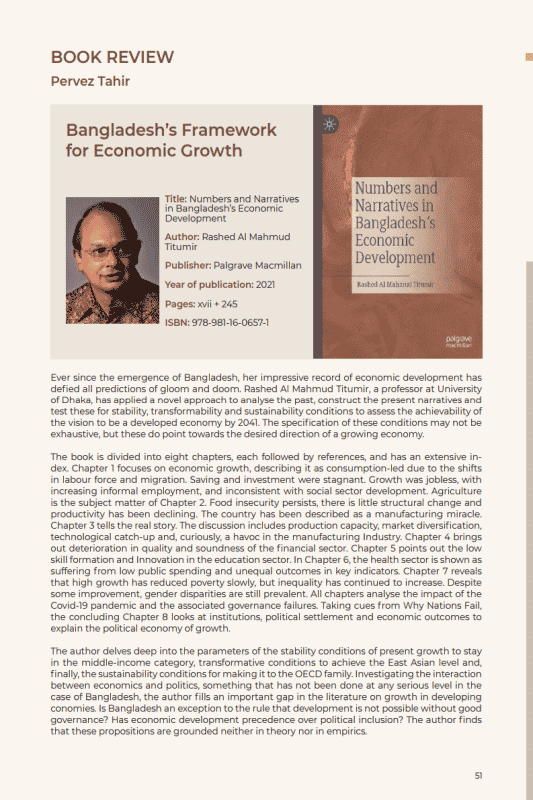
Pakistan Institute of Development Economics
- Home
Our Portals
MenuMenuMenuMenuMenuMenuMenu - ResearchMenuMenuMenuMenuMenuMenuMenu
- Discourse
- The PDR
- Our Researchers
- Academics
- Degree Verification
- Thesis Portal
- Our Portals
Bangladesh’s Framework for Economic Growth
Ever since the emergence of Bangladesh, her impressive record of economic development has defied all predictions of gloom and doom. Rashed Al Mahmud Titumir, a professor at University of Dhaka, has applied a novel approach to analyse the past, construct the present narratives and test these for stability, transformability and sustainability conditions to assess the achievability of the vision to be a developed economy by 2041. The specification of these conditions may not be exhaustive, but these do point towards the desired direction of a growing economy. The book is divided into eight chapters, each followed by references, and has an extensive index. Chapter 1 focuses on economic growth, describing it as consumption-led due to the shifts in labour force and migration. Saving and investment were stagnant. Growth was jobless, with increasing informal employment, and inconsistent with social sector development. Agriculture is the subject matter of Chapter 2. Food insecurity persists, there is little structural change and productivity has been declining. The country has been described as a manufacturing miracle. Chapter 3 tells the real story. The discussion includes production capacity, market diversification, technological catch-up and, curiously, a havoc in the manufacturing Industry. Chapter 4 brings out deterioration in quality and soundness of the financial sector. Chapter 5 points out the low skill formation and Innovation in the education sector. In Chapter 6, the health sector is shown as suffering from low public spending and unequal outcomes in key indicators. Chapter 7 reveals that high growth has reduced poverty slowly, but inequality has continued to increase. Despite some improvement, gender disparities are still prevalent. All chapters analyse the impact of the Covid-19 pandemic and the associated governance failures. Taking cues from Why Nations Fail, the concluding Chapter 8 looks at institutions, political settlement and economic outcomes to explain the political economy of growth.



